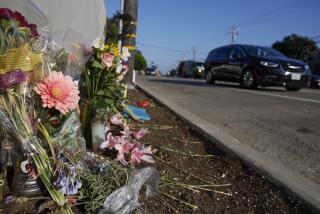Parents, Kids Make Strides for Traffic Safety
- Share via
The seven-minute walk home from school is usually uneventful for Pierpont Elementary School second-grader Connor Mazzola. But Wednesday was different.
Six uniformed officers from the Ventura Police Department, along with two police cadets, were on hand as noisy throngs of children spilled out of the Ventura school and scampered across busy Pierpont Boulevard.
The cadets, as usual, were working as crossing guards at the intersection at Bedford Court. But who was that woman in a colorful pantsuit, also helping out?
“OK, everyone, hold hands and let’s all walk safely!” said Assemblywoman Hannah-Beth Jackson.
The Santa Barbara Democrat was at the school to promote traffic safety as part of International Walk to School Day. Schools across Ventura County participated, along with an estimated 3 million walkers worldwide from South Korea to Saudi Arabia.
Jackson was also getting out the word that motorists who speed past schools will be paying much stiffer fines if caught. Under a law written by Jackson and enacted in January, fines are doubled for speeding tickets given in designated school zones.
Signs letting motorists know of the change were installed this week at Pierpont. The speed limit there is 25 mph when the school is in session. What once was a $200 ticket now costs $400, officials with the Ventura Police Department said.
“The goal, really, is to get people to drive more cautiously rather than hit them with big fines,” said Jackson, who was a crossing guard in the sixth grade. “We want people to slow down.”
Ventura County ranks eighth out of 58 counties in California for traffic injuries involving children younger than 15, and Santa Barbara County ranks 11th, according to a recent state study.
Connor’s mother, April Mazzola, is happy with the new traffic signs. She walks Connor to school every day and once saw a car almost hit a bicyclist.
“This is very good for our kids,” she said. “It will definitely be a deterrent, if it is enforced.”
It was much the same near other schools in Southern California.
In Santa Ana, the mile between Porfiria Espinosa’s home and her son’s school looms like a thousand when she considers the busy thoroughfares that stand between the two.
The streets are too foreboding and the distance too far for Espinosa to want to walk 5-year-old Jose to kindergarten every day. She normally drives him to school.
But on Wednesday morning they and throngs of other families from Washington Elementary walked to school to promote traffic safety and fight childhood obesity.
Nearly 50 Orange County schools participated in the walk-to-school event.
“It’s a little far, especially when I’m running late, but I realized today I should try to do it more often,” Espinosa said.
Many of the 1,400 students who attend Washington, Santa Ana’s largest elementary school, must cross congested streets including Warner Avenue, Flower Street and Bristol Street to get there.
But the more parents who walk to school, the safer it is because it cuts down on congestion from those who drive their children, said Carolyn Mertz, the Parent Teacher Assn. vice president at Buena Terra Elementary in Buena Park, where the event was held for the second time Wednesday.
“If parents felt their children were safe, they would let them walk to school,” Mertz said. “As it stands now, the way people drive around schools is insane.”
As at many other California schools, budget cuts have eliminated crossing guards at Buena Terra, at a time when cuts to bus service have forced even more students to walk.
That is why Washington Elementary parent Maria Flores, along with the majority of parents at that campus, always walks her fifth-grade son, Jonathan Ibarra, to school. “It gives me peace of mind,” Flores said as they headed down Flower Street.
Despite the number of years Walk to School Day has been held -- since 1994, when a handful of British schools piloted the event -- people need to be constantly reminded to be more careful in school zones, said UC Irvine traffic safety project coordinator Elaine Maae.
The university’s pediatric injury prevention research group provides most of the materials Orange County schools need to run their events.
“Everyone’s in too much of a rush nowadays,” Maae said. “They forget that even at 5 mph, a car can still do a lot of damage to a child.”
More to Read
Sign up for Essential California
The most important California stories and recommendations in your inbox every morning.
You may occasionally receive promotional content from the Los Angeles Times.














